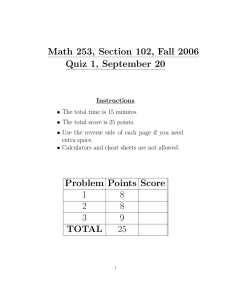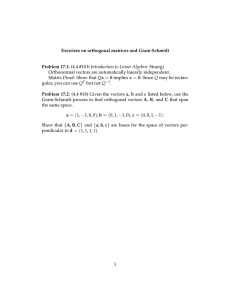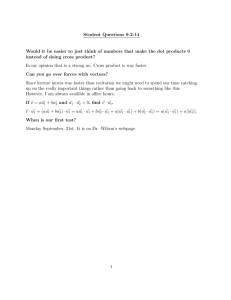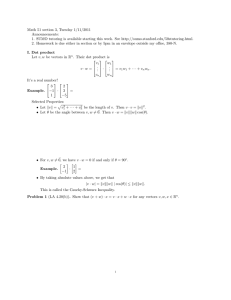Document 13739644
advertisement
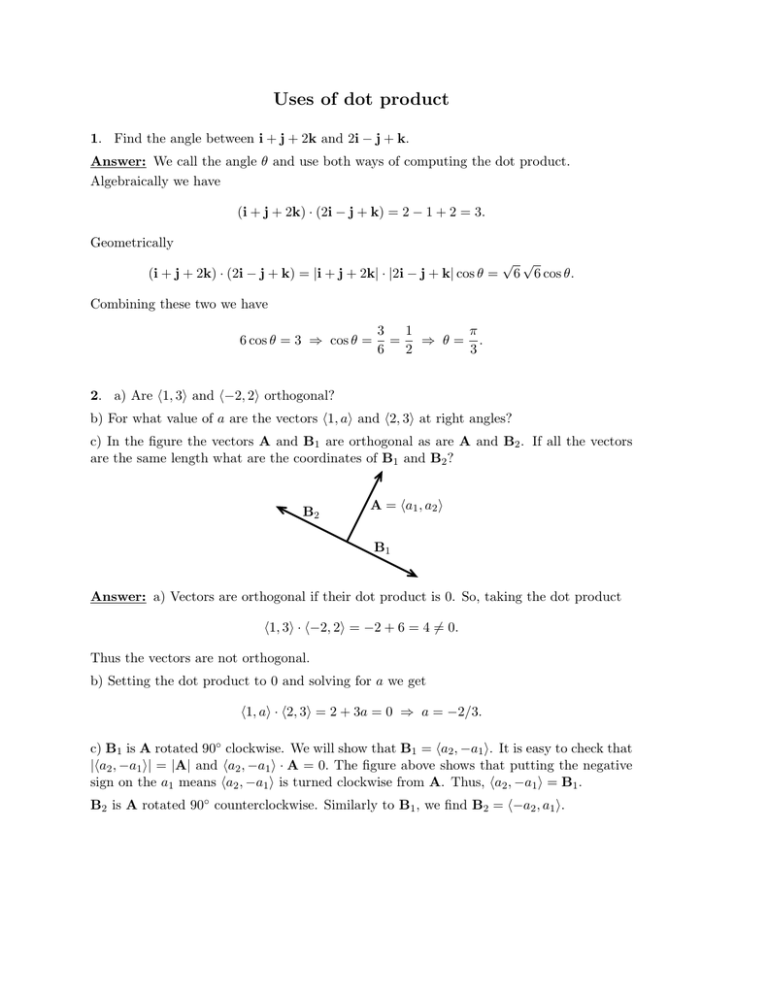
Uses of dot product 1. Find the angle between i + j + 2k and 2i − j + k. Answer: We call the angle θ and use both ways of computing the dot product. Algebraically we have (i + j + 2k) · (2i − j + k) = 2 − 1 + 2 = 3. Geometrically (i + j + 2k) · (2i − j + k) = |i + j + 2k| · |2i − j + k| cos θ = √ √ 6 6 cos θ. Combining these two we have 6 cos θ = 3 ⇒ cos θ = 3 1 π ⇒ θ= . = 6 2 3 2. a) Are �1, 3� and �−2, 2� orthogonal? b) For what value of a are the vectors �1, a� and �2, 3� at right angles? c) In the figure the vectors A and B1 are orthogonal as are A and B2 . If all the vectors are the same length what are the coordinates of B1 and B2 ? B2 A = �a1 , a2 � B1 Answer: a) Vectors are orthogonal if their dot product is 0. So, taking the dot product �1, 3� · �−2, 2� = −2 + 6 = 4 = � 0. Thus the vectors are not orthogonal. b) Setting the dot product to 0 and solving for a we get �1, a� · �2, 3� = 2 + 3a = 0 ⇒ a = −2/3. c) B1 is A rotated 90◦ clockwise. We will show that B1 = �a2 , −a1 �. It is easy to check that |�a2 , −a1 �| = |A| and �a2 , −a1 � · A = 0. The figure above shows that putting the negative sign on the a1 means �a2 , −a1 � is turned clockwise from A. Thus, �a2 , −a1 � = B1 . B2 is A rotated 90◦ counterclockwise. Similarly to B1 , we find B2 = �−a2 , a1 �. 3. Using vectors and dot product show the diagonals of a parallelogram have equal lengths if and only if it’s a rectangle Answer: D C A B We will make use of two properties of the dot product 1. v · v = |v|2 . 2. v · w = 0 ⇔ v ⊥ w. Referring to the figure, we will also need to use the fact that ABCD is a parallelogram. −−→ −−→ That is, AB = DC. −−→ −−→ −−→ −−→ −−→ −−→ −−→ −−→ We have AC = AB + BC and BD = BC + CD = BC − AB. Taking dot products: −−→ −−→ −−→ −−→ −−→ −−→ −−→ −−→ −−→ −−→ −−→ |AC|2 = AC · AC = (AB + BC) · (AB + BC) = |AB|2 + 2AB · BC + |BC|2 . and −−→ −−→ −−→ −−→ −−→ −−→ −−→ −−→ −−→ −−→ −−→ |BD|2 = BD · BD + (BC − AB) · (BC − AB) = |BC|2 − 2BC · AB + |AB|2 Comparing the two equations above we see −−→ −−→ −−→ −−→ |AC|2 = |BD|2 ⇔ 4AB · BC = 0. −−→ −−→ This shows the diagonals have the same length if and only if AB ⊥ BC. That is, if and only if the sides of the parallelogram are orthogonal to each other. QED MIT OpenCourseWare http://ocw.mit.edu 18.02SC Multivariable Calculus Fall 2010 For information about citing these materials or our Terms of Use, visit: http://ocw.mit.edu/terms.
